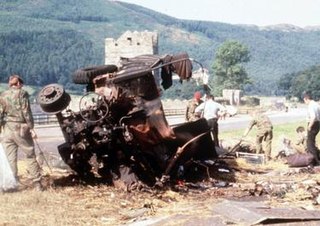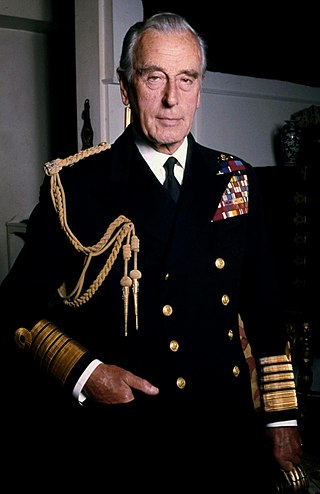
The Provisional Irish Republican Army, officially known as the Irish Republican Army and informally known as the Provos, was an Irish republican paramilitary force that sought to end British rule in Northern Ireland, facilitate Irish reunification and bring about an independent republic encompassing all of Ireland. It was the most active republican paramilitary group during the Troubles. It argued that the all-island Irish Republic continued to exist, and it saw itself as that state's army, the sole legitimate successor to the original IRA from the Irish War of Independence. It was designated a terrorist organisation in the United Kingdom and an unlawful organisation in the Republic of Ireland, both of whose authority it rejected.
The Real Irish Republican Army, or Real IRA (RIRA), was a dissident Irish republican paramilitary group that aimed to bring about a United Ireland. It was formed in 1997 following a split in the Provisional IRA by dissident members, who rejected the IRA's ceasefire that year. Like the Provisional IRA before it, the Real IRA saw itself as the only rightful successor to the original Irish Republican Army and styled itself as simply "the Irish Republican Army" in English or Óglaigh na hÉireann in Irish. It was an illegal organisation in the Republic of Ireland and designated a proscribed terrorist organisation in the United Kingdom and the United States.

From 1969 until 1997, the Provisional Irish Republican Army (IRA) conducted an armed paramilitary campaign primarily in Northern Ireland and England, aimed at ending British rule in Northern Ireland in order to create a united Ireland.

The Warrenpoint ambush, also known as the Narrow Water ambush, the Warrenpoint massacre or the Narrow Water massacre, was a guerrilla attack by the Provisional Irish Republican Army (IRA) on 27 August 1979. The IRA's South Armagh Brigade ambushed a British Army convoy with two large roadside bombs at Narrow Water Castle outside Warrenpoint, Northern Ireland. The first bomb was aimed at the convoy itself, and the second targeted the incoming reinforcements and the incident command point (ICP) set up to deal with the incident. IRA volunteers hidden in nearby woodland also allegedly fired on the troops, who returned fire. The castle is on the banks of the Newry River, which marks the border between Northern Ireland and the Republic of Ireland.
Events during the year 1979 in Northern Ireland.
The Ballygawley bus bombing was a roadside bomb attack by the Provisional Irish Republican Army (IRA) on a bus carrying British soldiers in Northern Ireland. It occurred in the early hours of 20 August 1988 in the townland of Curr near Ballygawley, County Tyrone. The attack killed eight soldiers and wounded 28. In the wake of the bombing, the British Army began ferrying its troops in and out of County Tyrone by helicopter.

On 23 July 1974, a small bomb was found aboard a British Airways flight from Aldergrove Airport, near Belfast, to London, following a telephoned warning. The flight made an emergency landing at Manchester Airport. The Provisional Irish Republican Army (IRA) claimed it had planted the bomb as a symbolic act, and that it had not been set to explode. It is the only time that the IRA has planted a bomb aboard an aircraft, and was the second terrorist incident involving a bomb aboard an aircraft in the United Kingdom.

Louis Mountbatten, 1st Earl Mountbatten of Burma, a relative of the British royal family, was assassinated on 27 August 1979 by Thomas McMahon, an Irish republican and a volunteer for the Provisional Irish Republican Army (IRA).
The 1987 Rheindahlen bombing was a car bomb attack on 23 March 1987 at JHQ Rheindahlen military barracks, the British Army headquarters in West Germany, injuring thirty-one. The large 300 lb (140 kg) car bomb exploded near the visitors officers' mess of the barracks. The Provisional IRA later stated it had carried out the bombing. It was the second bombing in Rheindahlen, the first being in 1973, and the start of the IRA's campaign on mainland Europe from the late 1980s to the early 1990s. Although British soldiers were targeted, most of the injured were actually German officers and their wives.
The Provisional IRA carried out two separate attacks on the same day on 1 May 1988 against British military personnel in the Netherlands which resulted in the deaths of three RAF members and another three being injured. It was the worst attack suffered by the British security forces during The Troubles from 1969 to 1998 in mainland Europe.

In the Ballygawley land mine attack of 13 July 1983, four soldiers of the British Army's Ulster Defence Regiment (UDR) were killed by a Provisional Irish Republican Army (IRA) land mine near Ballygawley in County Tyrone, Northern Ireland. The soldiers were travelling in a convoy of armoured vehicles when the land mine was detonated remotely.
On 9 April 1990, the South Down Brigade of the Provisional Irish Republican Army (IRA) detonated a massive improvised land mine under a British Army convoy outside Downpatrick, County Down, Northern Ireland. Four soldiers of the Ulster Defence Regiment (UDR) were killed, the regiment's greatest loss of life since 1983.
On 22 August 1972 a bomb planted by the Provisional Irish Republican Army, an Irish republican paramilitary group, detonated prematurely at a customs office in Newry. Three IRA members killed six civilians and themselves in the explosion. The event was one of the bloodiest of 1972, the deadliest year of the Troubles.
In the Altnaveigh landmine attack of 19 May 1981, five British soldiers were killed and their armoured vehicle destroyed by a Provisional IRA landmine at Altnaveigh, a rural area outside Newry in County Armagh, Northern Ireland. The landmine was detonated remotely when the vehicle passed over it. The attack happened during a period of heightened tension over the 1981 Irish hunger strike.
This article covers attacks and activity of terrorism in Belgium.
In the Dungannon land mine attack of 16 December 1979, the Provisional Irish Republican Army (IRA) ambushed two British Army Land Rovers with an improvised land mine outside Dungannon, County Tyrone, Northern Ireland. Four British soldiers were killed in the attack.
The Duke of Edinburgh's Royal Regiment Band was a military band of the British Army that served as the regimental band of the Duke of Edinburgh's Royal Regiment from 1959 to 1994. During its existence, the regimental band maintained a corps of drums alongside its band that took part in many different ceremonies on behalf of the regiment.
The Provisional IRA in the Republic of Ireland was very active in the country during the Troubles (1969–1998). The country was seen as a safe haven for IRA members who used it to flee from British security forces, organize training and homemade weapons, and conduct attacks on British or Loyalist targets in nearby Northern Ireland, England, and even continental Europe. Irish authorities viewed armed activity by Irish republican militants in their country as a major security risk and took steps to mitigate it. They censored representatives of such militants from appearing on television or radio by Section 31 of the Broadcasting Act, introduced the non-jury Special Criminal Court to easily prosecute the militants, and made it illegal to be members of certain Republican militant organisations.
This is a timeline of the events and actions during the Troubles that were carried out in Western Europe, the countries included are West Germany, Belgium & the Netherlands the vast majority of which were carried out by Provisional IRA (PIRA) the other Irish Republican group was the Irish National Liberation Army (INLA) who carried out a small few attacks more for propaganda purposes. According to a study 18 people were killed on mainland Europe during The Troubles with around 60 people being injured.






